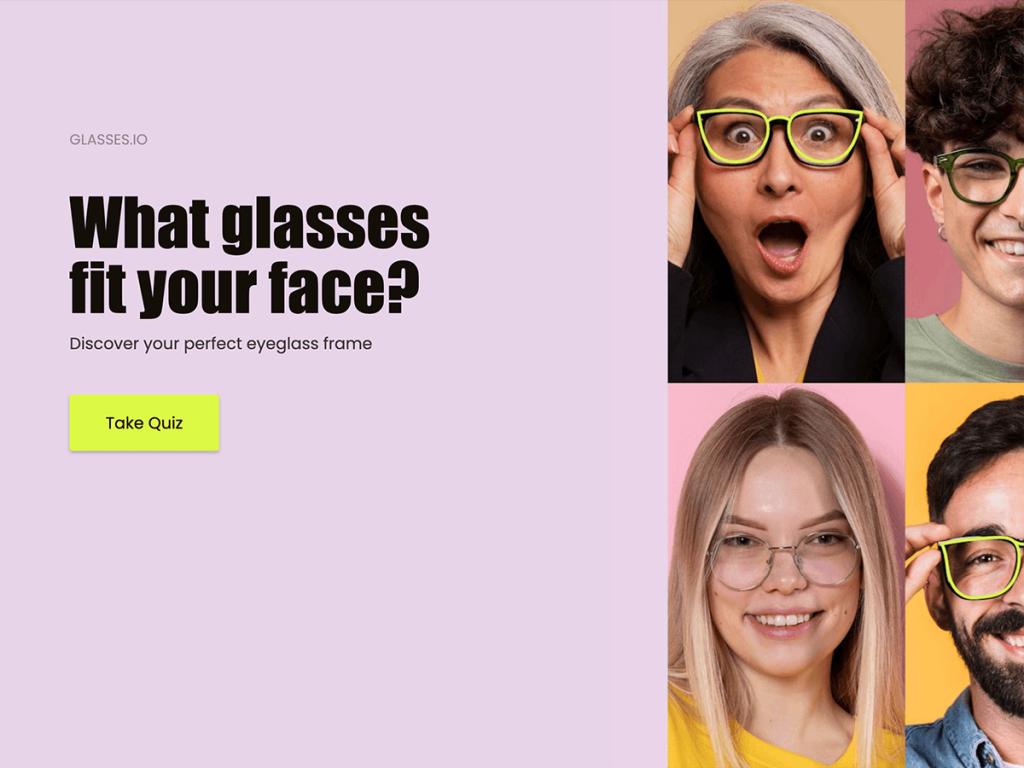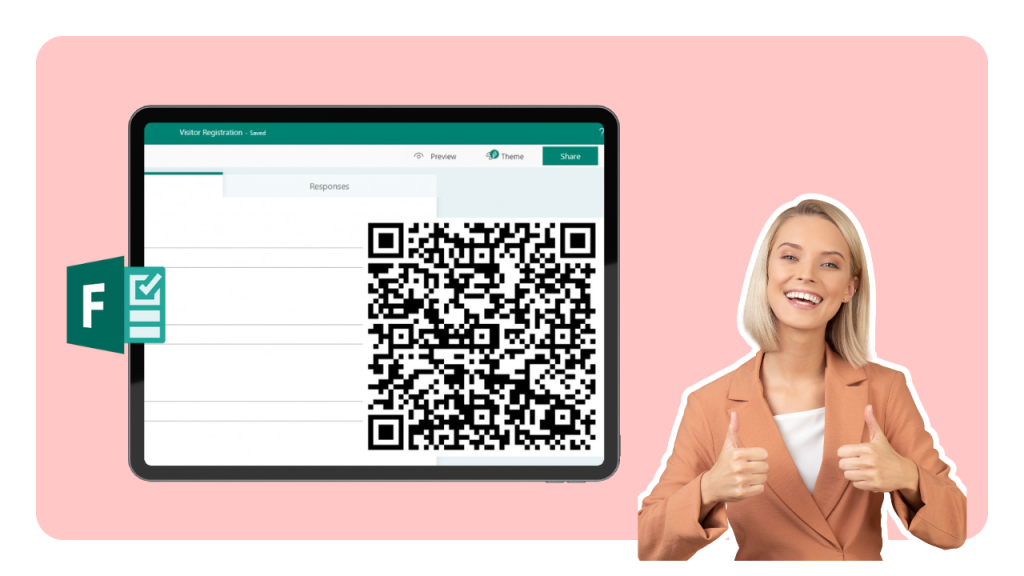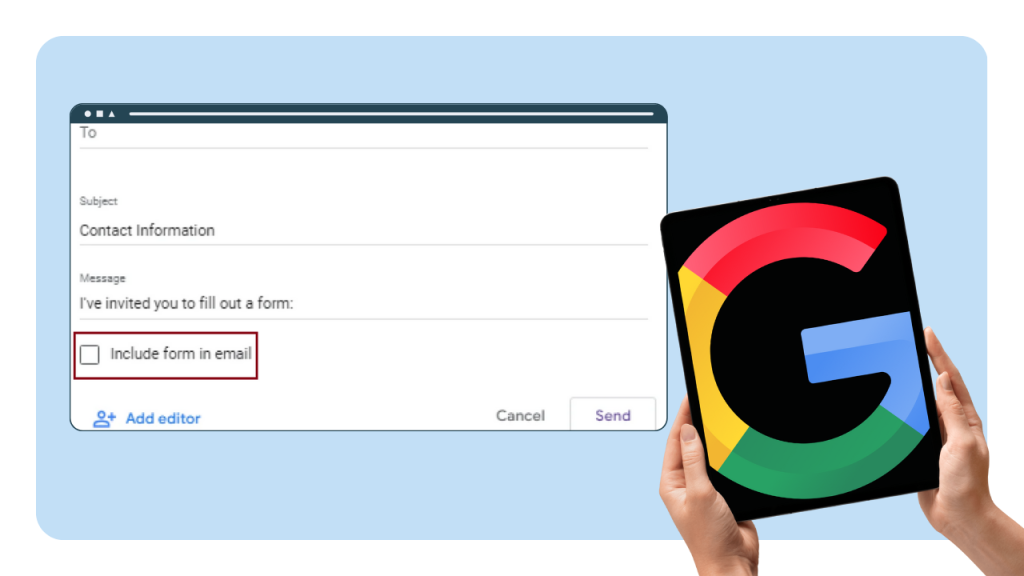You’ve tested headlines. Swapped CTA colors. Moved sections around. Conversions barely move. Sound familiar?
Here’s the real issue: most tweaks change how the page looks, not how it interacts. A static page grabs attention for a moment. It rarely captures intent.
The breakthrough comes from engagement. When you guide visitors through an interactive, adaptive experience, they participate. They share context. They stick around. And they convert.
This guide shows you how to move from passive pages to engagement-first funnels that turn traffic into qualified leads.
What you’ll learn:
Why traditional CRO plateaus once basics are in place, and why small UI tests stop paying off.
How engagement-first funnels work and lift conversions
Practical funnel elements to use like quizzes, calculators, and guided forms, with examples for B2B and B2C.
A step-by-step migration plan to replace static pages with interactive flows
How to qualify in real time using conditional logic, ICP rules, and outcome-based CTAs.
Integration best practices, optimization tactics and reporting frameworks
The CRO Plateau: Why Static Page Tweaks Stop Working
Most teams follow the same optimization routine: A/B test the headline, swap the hero image, change the CTA color, move sections around, or remove navigation links. These changes might lift conversions from 1% to 3%, but after that, progress stalls. The reason is simple: you’re improving the presentation layer, not the engagement layer.
A visually perfect page that behaves like a brochure is still a one-way message. People skim. They bounce. You polish the frame without changing the conversation.
Here’s the kicker. Static pages often convert in the low single digits. Interactive, multi-step experiences routinely pull much higher. Quizzes, calculators, guided forms. These formats get 3 to 5 times more opt-ins because users participate instead of just reading.
The takeaway: if your layout is solid and numbers still disappoint, the limiter is the format. Change the experience, not only the cosmetics.
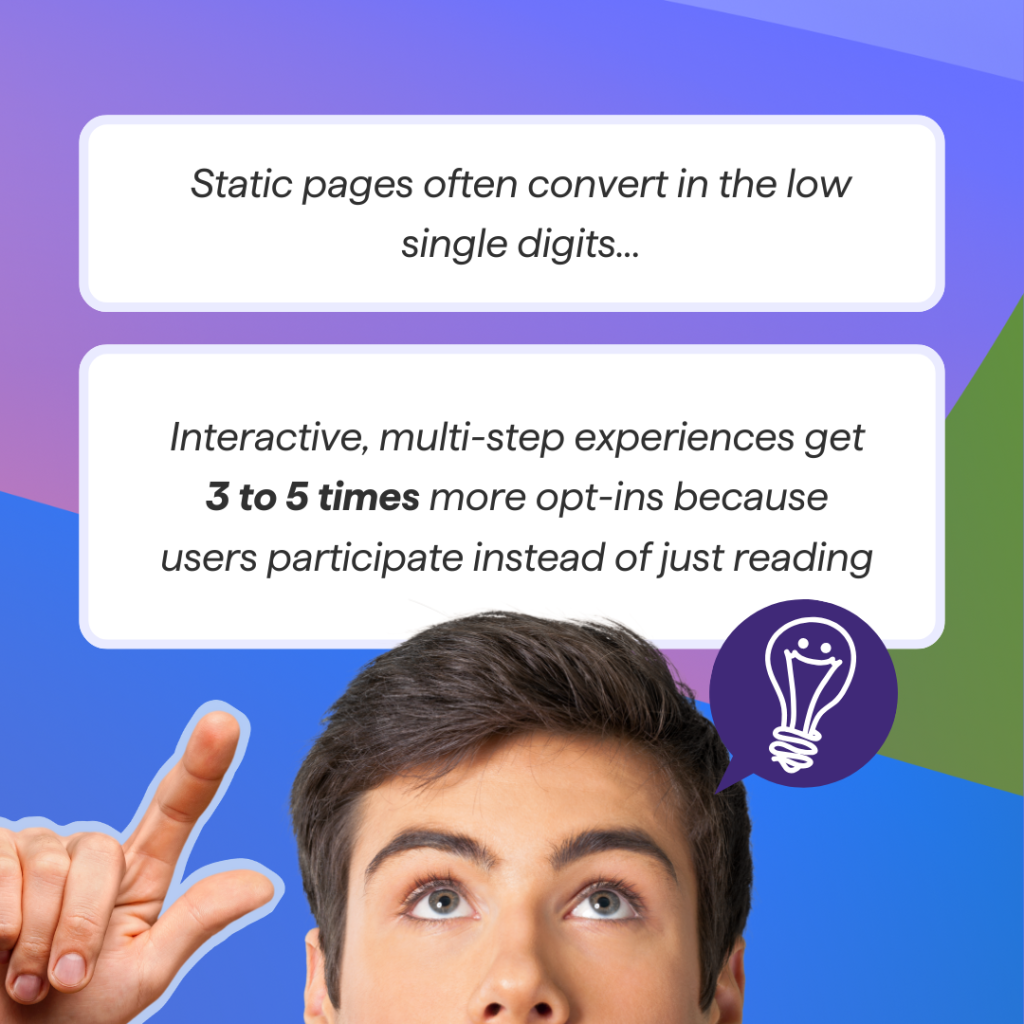
The Hidden Problem: Low Engagement Means No Data, No Personalization
Static pages create a silent failure loop. Visitors either convert or leave. You learn nothing about the 95% who bounce.
What that costs you:
No segmentation. Everyone gets the same pitch. The solo founder and the enterprise buyer see identical content. Relevance suffers.
No feedback loop. You don’t capture needs, objections, priorities. You cannot qualify. You cannot tailor.
No guided journey. It is convert or exit. No steps to warm people up. No micro-yeses. No second chance on that visit.
Contrast that with an interactive funnel. Now you know who started, who finished, what they care about, and who meets your criteria. You collect intent signals and zero-party data. You personalize follow-up. You route sales-ready leads faster.
The issue is not only design. It is the one-size-fits-all approach. Fix engagement and you unlock the data that improves conversion.
Beyond the Page: What Actually Drives Conversions
If conversions are low, the landing page might be innocent. Look upstream.
Audience Targeting and Segmentation
Right visitor beats pretty page. Always.
Audit fit and intent: Check sources. Tighten targeting. Use ABM lists or lookalikes that mirror your best customers.
Match message to stage: Cold audiences need education and light interaction. Warm audiences can handle calculators, pricing, or demos.
Test smaller, high-intent slices: Fewer visits, better leads, higher ROI.
Traffic Quality and Source Alignment
Not all clicks are equal.
Align source to promise: If the ad says “Free ROI analysis,” the page should deliver an ROI analysis.
Analyze by channel: Break down by UTM. Reallocate budget to what converts.
Fix mismatches: When a source sends low-intent traffic, pause or retune targeting and copy.
Offer and Value Proposition
Sometimes the design is fine. The offer is not.
Lead with benefits: “Personalized 30-minute demo to uncover hidden revenue” beats “Book a demo.”
Reduce friction: Shorter forms. Break commitments into steps.
Match to funnel stage: Top of funnel loves quizzes, scorecards, and tools. Mid-funnel wants comparisons and case studies. Bottom-funnel says yes to trials, pricing, and short consults.
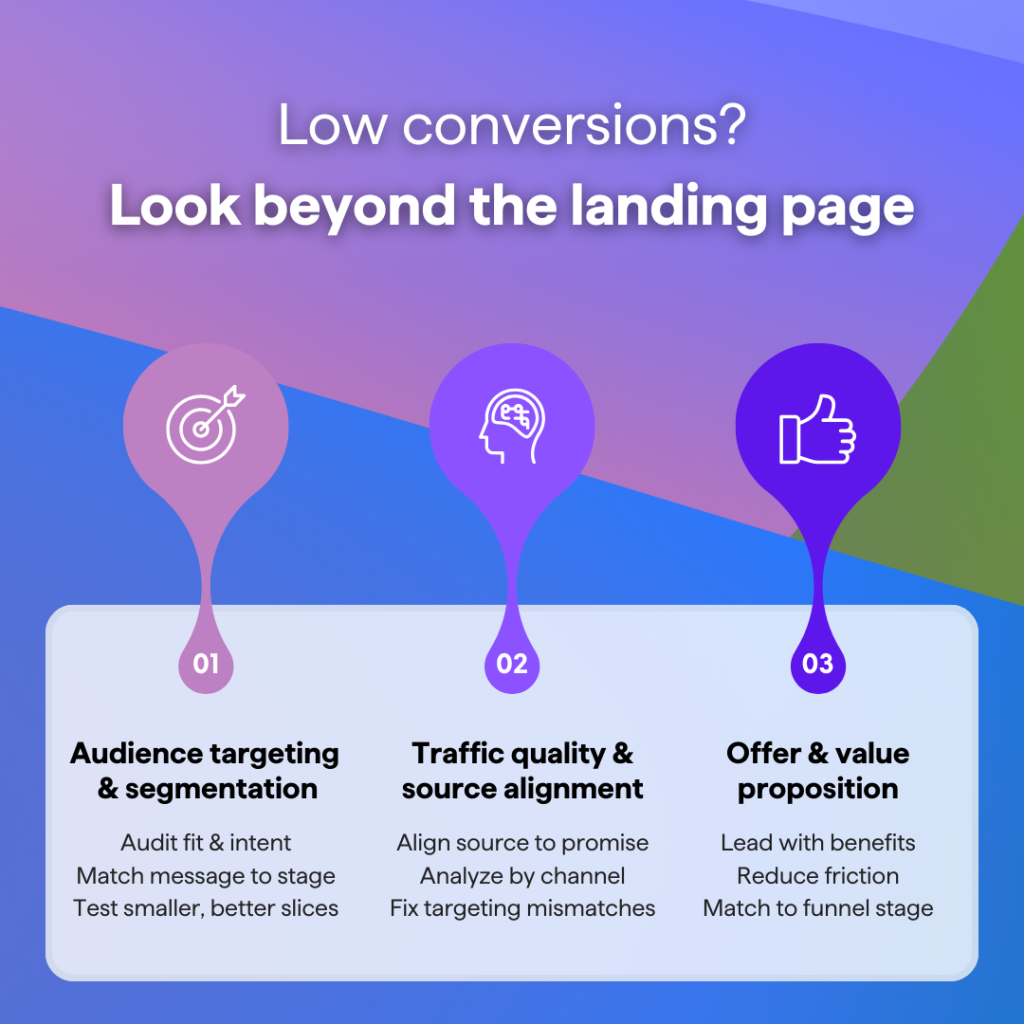
The Engagement-First Approach: Funnels That Adapt To Each Visitor
What replaces the static page? An interactive, multi-step funnel that adapts in real time.
Think quizzes, calculators, surveys, guided forms. The visitor answers. The experience responds. Every step builds intent and trust. People value what they help create. Call it the IKEA effect, applied to conversions.
Examples that outperform:
“Find Your Ideal Plan” quiz. Ask a few questions, recommend a plan. Feels tailor-made.
ROI calculator. Visitors plug in their numbers and get projected impact. You qualify while delivering value.
Self-assessment survey. Score, gaps, personalized recommendations. Great for B2B.
Bottom line: engagement is the new optimization.
Create your own online funnels
Get started with a template
Appointment Funnel Template
Glasses Recommendation Funnel Template
ROI Calculator Template
Proof Point: Forms Vs Funnels
Here’s what real-world tests reveal when you compare static single-step forms with dynamic, multi-step funnels designed to guide rather than demand.
Experiment / Finding | Single-Step / Baseline | Multi-Step / Funnel / Improved |
HubSpot (Multi-Step Performance) | baseline | +86% higher conversion vs. single-step forms |
Venture Harbour (Case Study) | — | 53% of site visitors converted via a multi-step form |
Venture Harbour (Form Length Experiments) | — | +35%, +59%, +214% uplift after switching to multi-step forms |
What the Data Shows
Across multiple independent studies and A/B tests, multi-step funnels consistently outperform static single-page forms, often by 20 – 80% or more.
Marketers see higher completion rates, lower abandonment, and better-qualified leads by transforming long forms into short, guided sequences.
Why the Big Gap?
A traditional form asks for information before giving anything back. A funnel turns that hurdle into a helpful process: value first, data second. Each step builds trust and intent. By the time the form appears, the visitor is invested in reaching the result and far more likely to finish.
How To Transition From Static Pages To Interactive Funnels (Step-by-Step Guide)
Ready to move beyond static pages? Building an engagement-first funnel isn’t as complex as it sounds. Here’s how to turn underperforming pages into high-converting, data-driven funnels.
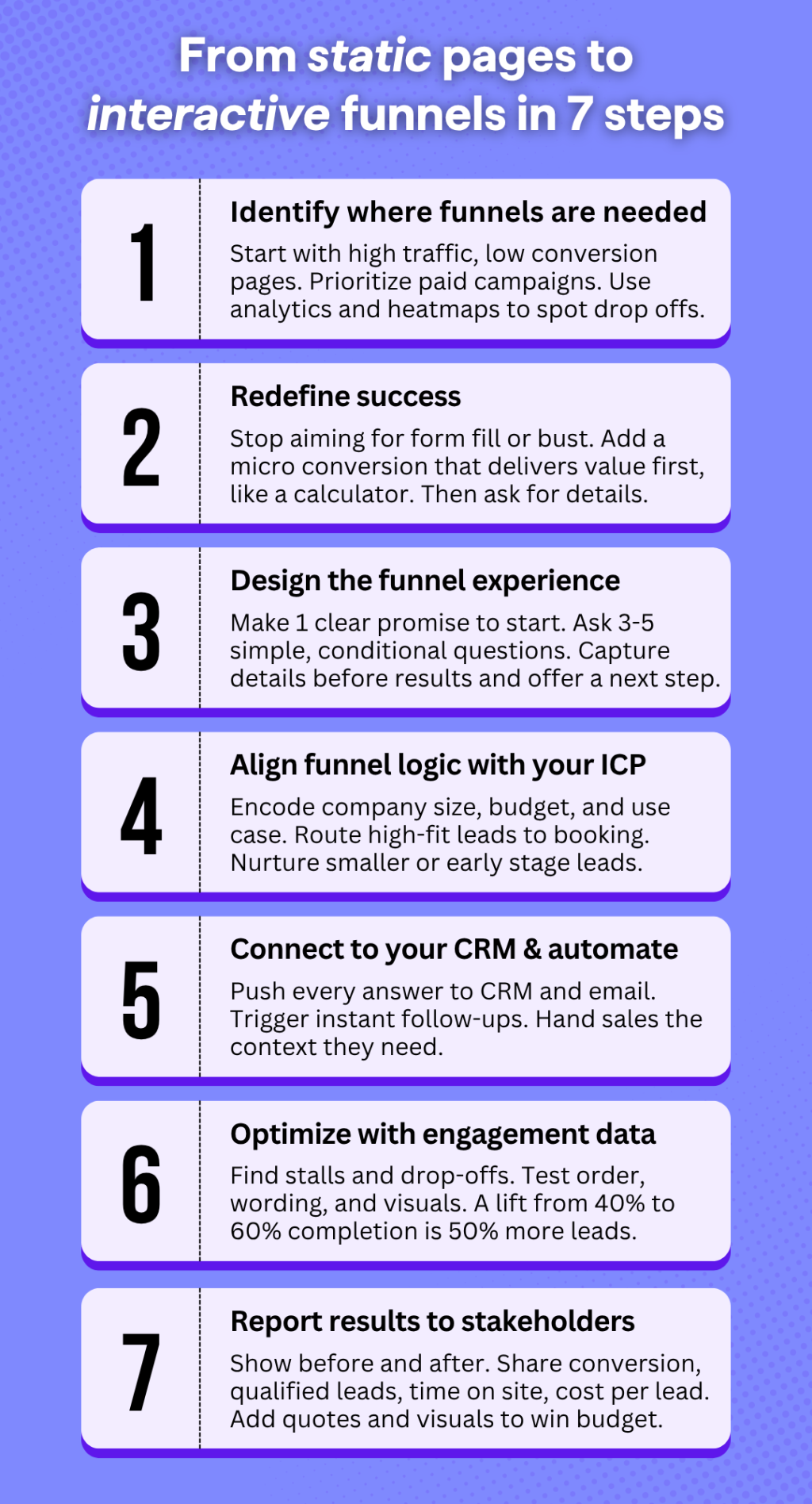
1. Identify Where Funnels Are Needed
Start with high-traffic, low-converting pages, anything under 5% conversion is a good target. Focus especially on paid traffic sources like Google or LinkedIn Ads where ROI matters most.
Use tools like Google Analytics, Hotjar, or Microsoft Clarity to find drop-offs and understand where visitors lose interest. These are your best opportunities to test an interactive funnel.
2) Redefine Success
Static pages ask for data upfront; funnels offer value first. Replace “Submit your info” with an engaging step like a quiz, calculator, or self-assessment. Each interaction is a micro-conversion that warms users up before you ask for their contact details.
This value-first approach turns form fills into a two-way exchange, users get insights, and you get qualified leads.
3) Design the Funnel Experience
Structure it like a conversation:
Intro screen. One clear promise. One tap to start.
3–5 qualifying steps. Multiple choice, sliders, simple inputs. Use conditional logic to keep it relevant.
Lead capture at the right moment. Right before the results. Minimal fields.
Outcome page. Personalized results plus a next step that makes sense. Demo, consult, trial, download.
Keep it friendly and fast. Show progress. Set expectations.
Pro Tip: Modern funnel builders make this easy. involve.me even includes an AI Funnel Generator to draft a working flow you can refine.
4) Align Funnel Logic With Your ICP
Use conditional logic to route and qualify leads based on your ideal customer profile (budget, company size, or use case).
For example, smaller businesses might see a “Download Guide” CTA, while enterprise leads get a scheduler for a consultation.
This ensures your sales team focuses on high-value prospects while others enter automated nurture flows.
5) Connect To Your CRM And Automation
Integrate your funnel with HubSpot, Salesforce, or ActiveCampaign so every lead and response syncs automatically.
Automation triggers instant follow-ups, personalized emails, and Slack alerts for sales teams.
Because all quiz data flows into your CRM, reps can reach out with context (“I saw your top challenge was ROI optimization, here’s how we can help”).
Fast, tailored responses convert better than generic ones.
6) Optimize Using Engagement Data
Once live, track where users start, drop off, and convert. If many leave on one step, simplify it. Test shorter questions, reworded CTAs, or different outcomes.
Use funnel analytics to see which segments convert best and adjust ad targeting accordingly.
Small improvements like increasing funnel completion from 40% to 60% can yield massive gains over time..
7) Report and Scale Results
Show the before-and-after impact. Compare conversion rates, qualified leads, and engagement metrics (like time on page or completion rate).
Visualize results with dashboards or CRM reports and include sales feedback or user quotes. Use these wins to justify expanding funnel experiments across more campaigns or clients.
Complementary Tactics That Multiply Conversion Impact
Interactive funnels can significantly lift your conversions, but they’re even more effective when combined with broader marketing tactics. Here are some complimentary tactics that you can use to multiply your conversions.
Personalization Across the Journey
Don’t stop personalizing once the funnel ends, extend it throughout the customer journey. Tailored experiences can increase B2B conversions by up to 80%. Use the data gathered from your funnel to adjust landing pages, emails, and website content based on what you know about each lead.
For example, if a lead’s answers show they work in ecommerce, show them ecommerce-specific case studies and solutions. Personalized calls-to-action such as “View Your Recommended Plan, Sarah” perform far better than generic ones, and have 202% higher click-through rates. The goal is to make every interaction feel relevant. When people feel your brand understands them, engagement and conversions both rise.
Lead Nurturing
Most leads aren’t ready to buy immediately, and that’s fine. About 80% of new leads never convert simply because they’re not nurtured. Keep engaging them through helpful follow-ups, relevant content, and reminders. The goal is to be consistent and build trust until they’re ready to make a decision.
Marketing Automation & CRM Integration
Automation ensures every lead receives the right message at the right time. Connect it to tools like HubSpot or ActiveCampaign to track, score, and follow up with leads automatically.
Set up workflows that trigger personalized emails based on funnel responses or user behavior, and use lead scoring to identify who’s most likely to convert. Syncing this data between systems gives your sales team complete visibility into each lead’s journey. It also helps you measure which funnels drive the most revenue so you can double down on what works. The result is a system that scales personalization without manual effort.
Continuous Behavioral CRO
Conversion optimization isn’t a one-time task, it’s an ongoing process. Keep analyzing how users interact with your funnel using tools like session recordings, heatmaps, and analytics reports. If you notice drop-offs at a specific step, simplify the question or layout. Experiment with different funnel types, question flows, or outcome pages to find what performs best. As your business evolves, update your funnel content to reflect new offers or audience priorities.
Example: What an Engagement-First Funnel Looks Like (Turning a Static B2B Page into an ROI Funnel)
Scenario: a B2B SaaS with a “Request a Demo” page at 3% conversion. Visitors are not ready for a sales call.
New concept: “Find Your Marketing ROI Potential” quiz.
Flow
Intro: “Take 5 quick questions to estimate your ROI lift. Get a custom report in under a minute.”
Questions: The quiz asks five short questions about budget, top channels, lead volume, challenges, and industry. Each appears on a separate screen with progress tracking. Conditional logic personalizes follow-up questions so the quiz feels relevant.
Lead capture: After the final question, users see “Calculating your ROI potential…” then a prompt to enter their email to get results. Most comply since they’re already engaged.
Outcome: “Your ROI could improve by 28%.” Tailored insights plus CTA to book a 15-minute consult or start a trial.
Follow-up: Auto email with the summary and a booking link. Sales gets the answers in CRM with context for outreach.
Results:
Out of 500 visitors, 250 start the quiz and 150 complete it, a 30% conversion rate, up from 3%. Fifty are high-quality leads sent to sales; the rest enter a nurture sequence. Conversations become more relevant, and deal flow increases dramatically.
An engagement-first funnel like this turns a static form into a helpful experience that delivers value first and collects qualified leads naturally.
You can build a funnel like this quickly with a no-code tool like involve.me. Its AI Agent can generate funnel drafts, questions, and logic for you in minutes, you just refine and launch
Build Your First Interactive Funnel Today
Small UI tests won’t fix a passive experience. Shift the visit from reading to participating.
Lead with value. Guide people through a short, relevant flow. Then invite the next step.
Here’s the move:
Pick one underperforming page.
Replace the static form with a 5-step quiz or calculator.
Map answers to your ICP and route high-fit leads.
Send results to your CRM for instant, personalized follow-up.
Iterate using drop-off and outcome data.
You can spin this up fast with involve.me. Its AI Agent drafts questions, outcomes, and logic in minutes, so you can refine and launch quickly.
Turn that page into a real conversation. Watch conversions, and lead quality, climb.
Create a landing page in minutes
No coding, no hassle, just better conversions.



